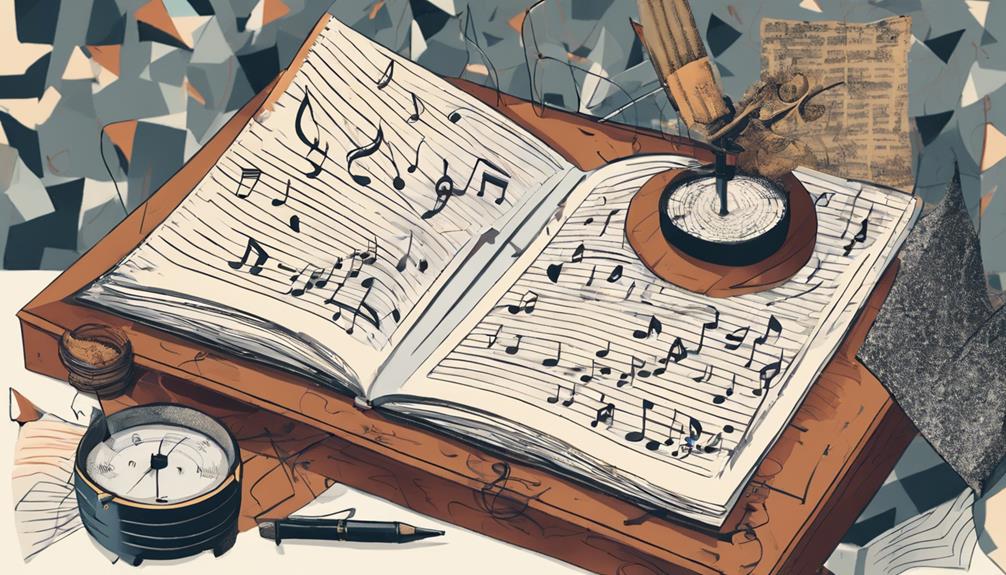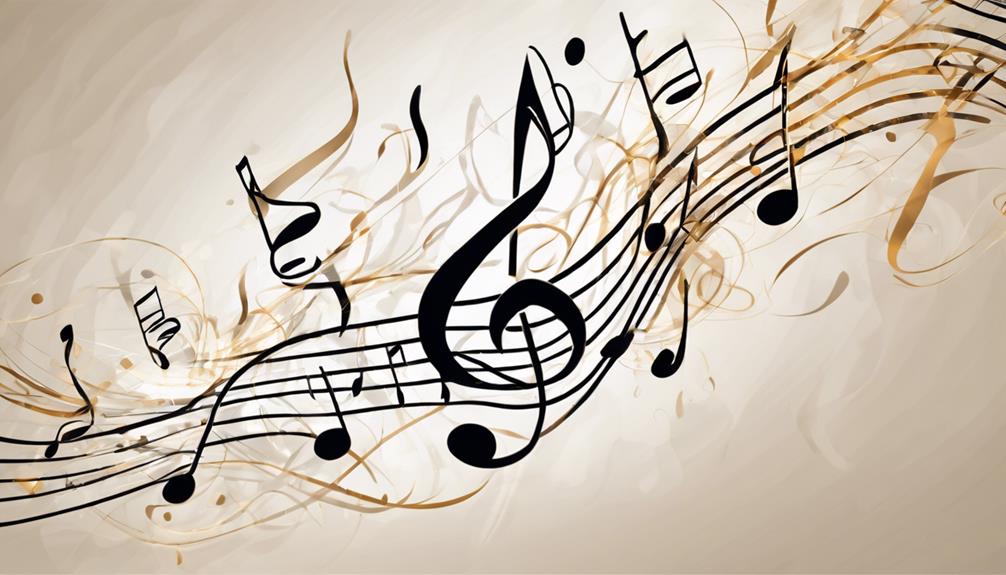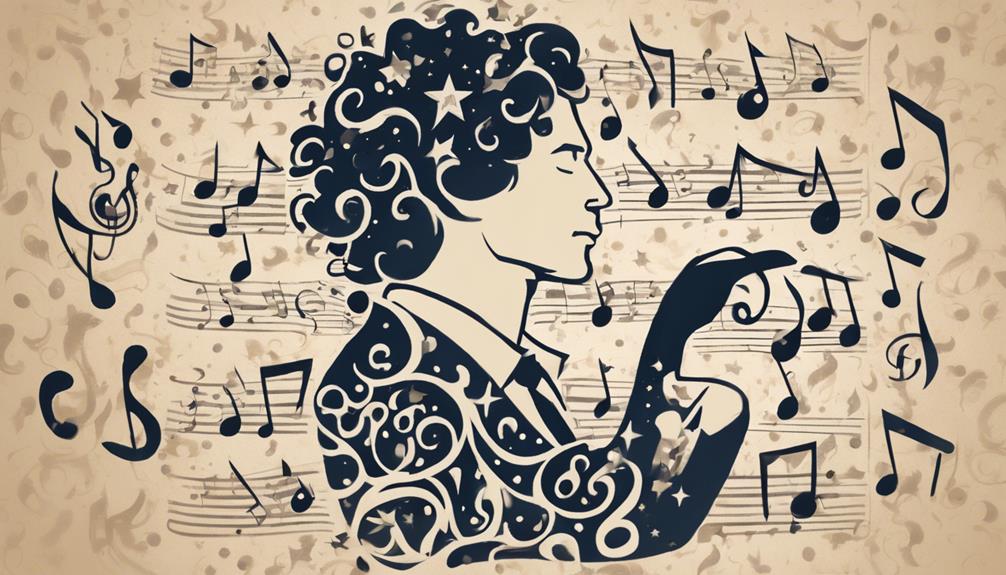As you explore the world of poetry, you'll find that mastering rhythm and rhyme is essential to crafting verses that resonate with readers. Crafting rhythm involves balancing syllables, stresses, and pauses, while rhyme schemes orchestrate harmonious sounds. A delicate balance between musicality and precision is key, and mastering syntactic flow enhances sound. Meter infuses language with a rhythmic pulse, and varying stress on syllables adds layers of meaning. With a nuanced understanding of phonetics, syntax, and lineation, you'll reveal the secrets of poetic musicality. As you continue on this poetic journey, you'll discover the subtle nuances that elevate poetry to a symphony.
Crafting Rhythm in Poetry

As you explore the world of poetry, you'll find that crafting rhythm is an intricate dance of syllables, stresses, and pauses that, when mastered, can elevate your verse from mere words to a harmonious symphony of sound. To achieve this, you'll need to balance silent beats – the pauses between words – with sonic layers, which refer to the varying degrees of loudness and softness in your words. By doing so, you'll create a rhythmic flow that engages your readers and conveys the emotional depth of your poetry. Consider the iambic rhythm, where an unstressed syllable is followed by a stressed one, creating a heartbeat-like pulse. Experiment with caesura – strategic pauses within a line – to add drama and tension. As you refine your craft, you'll discover that rhythm is not just about the sounds, but also the silences in between, working together to create a rich tapestry of sound. By mastering rhythm, you'll reveal the full potential of your poetry, transforming it into a captivating experience for your readers.
Rhyme Schemes and Patterns

When you're crafting a rhyme scheme, you're essentially orchestrating a harmonious union of sounds, where the recurrence of similar sounds at regular intervals creates a sense of musicality that can elevate your poetry to new heights. A well-crafted rhyme scheme can add depth, complexity, and emotional resonance to your poetry. There are two primary types of rhymes to ponder: End Rhyme and Internal Rhyme. End Rhyme, the most common type, involves identical sounds at the end of words or lines. Internal Rhyme, on the other hand, involves identical sounds within words or lines. You can experiment with different patterns, such as alternating rhymes, enclosed rhymes, or chain rhymes, to create a unique sound signature. By mastering rhyme schemes and patterns, you can create a rich sonic tapestry that complements the meaning and emotion of your poetry. Remember, the key to a successful rhyme scheme is to strike a balance between predictability and surprise, creating a sense of anticipation and fulfillment in your readers.
Balancing Sound and Sense

In crafting poetry, you must navigate the delicate balance between the musicality of sound and the precision of sense, lest your rhymes ring hollow or your meaning gets lost in a cacophony of words. This balance is essential, as it allows you to harness the emotional resonance of phonic nuances while conveying complex ideas with clarity. To achieve this balance, you must carefully consider the interplay between sound and sense in every line, ensuring that your words not only sound harmonious but also convey precise meaning.
A key aspect of balancing sound and sense is mastering syntactic flow. By carefully crafting sentence structure and word order, you can create a seamless flow of sound that enhances the overall musicality of your poem. This, in turn, allows you to focus on refining the precision of your language, ensuring that every word and phrase contributes to the overall meaning of the poem. As you refine your craft, you'll find that the balance between sound and sense becomes increasingly intuitive, allowing you to create poetry that is both sonically rich and intellectually stimulating.
Enriching Meaning With Meter

Crafting a poem's meter allows you to infuse your language with a rhythmic pulse, subtly underscoring key themes and emotions while guiding the reader's tempo and emphasis. As you experiment with meter, you'll discover that it's not just about adhering to a specific pattern, but about harnessing the subtle power of syllable emphasis. By varying the stress on individual syllables, you can draw attention to specific words or ideas, adding layers of meaning to your poem.
In your footwork exploration, consider the way different meters can evoke distinct emotional responses. For instance, a steady iambic rhythm can create a sense of urgency, while a more languid trochaic beat can induce a sense of relaxation. As you refine your meter, remember that it's not just about technical precision, but about using rhythm to amplify the emotional resonance of your words. By doing so, you'll create a rich, dynamic soundscape that draws the reader into your poetic world.
Mastering Musicality in Verse

As you explore the world of mastering musicality in verse, you'll find that a nuanced understanding of phonetics, syntax, and lineation can elevate your poetry from mere words on a page to a symphony of sound and sense. This synergy of sound and sense is rooted in the sonic texture of your words, where the careful arrangement of consonants and vowels creates a rich tapestry of sound.
Frequently Asked Questions
Can a Poem Have Rhythm Without a Rhyme Scheme?
You might wonder, can a poem have rhythm without a rhyme scheme? Absolutely, you can create rhythm through Free Verse Exploration, focusing on natural speech patterns, cadence, and enjambment. Alternatively, you can employ Syllable Counting, controlling the flow of words to establish a rhythmic pulse. In fact, many poets deliberately eschew traditional rhyme schemes to prioritize other sonic elements, crafting unique, rhythm-rich experiences that defy conventional expectations.
How Do I Avoid Clichés in My Poem's Rhythm and Rhyme?
When crafting a poem, you'll often find yourself torn between authenticity and the ease of relying on familiar rhythms and rhymes. Theories suggest that our brains are wired to respond to patterns, making clichés a tempting crutch. To avoid them, focus on authentic phrasing that originates from your unique perspective. Fresh language can be achieved by experimenting with unexpected word pairings and syntax, allowing your poem's rhythm and rhyme to unfold organically, rather than relying on tired tropes.
Can I Use Slang or Colloquialisms in Formal Poetry?
When incorporating slang or colloquialisms into formal poetry, you're walking a fine line between authenticity and affectation. Urban dialect can add a layer of realism, but linguistic fusion can also feel forced or pretentious. Consider the context and audience: will they appreciate the nod to regional vernacular, or will it disrupt the poem's musicality? Weigh the benefits of colloquialism against the risks of datedness or exclusivity.
Do I Need to Be a Musician to Master Musicality in Poetry?
You don't need to be a musician to master musicality in poetry, but you do need to understand the nuances of sound and rhythm. Poetic license allows you to experiment with language, creating a lyrical flow that transcends traditional musicality. By paying attention to the cadence of words, you can craft a unique sound that resonates with readers. It's not about being a musician, but about developing an ear for the rhythm of language itself.
Can I Effectively Use Rhythm and Rhyme in Spoken Word Poetry?
You're wondering if you can effectively use rhythm and rhyme in spoken word poetry without being a musician. The answer lies in your ability to harness vocal inflections and performance dynamics. By modulating your tone, pace, and volume, you can create a rhythmic flow that engages your audience. Experiment with emphasis, pauses, and cadence to convey emotional depth, making your spoken word poetry a mesmerizing experience.


